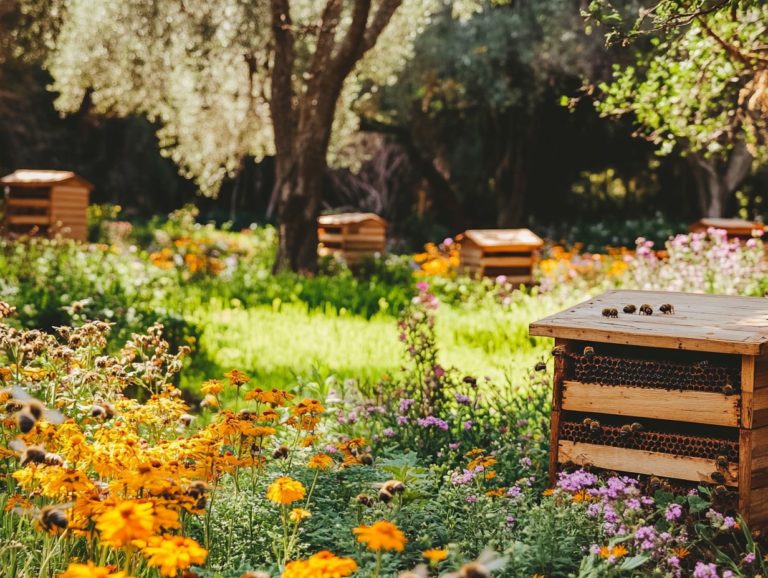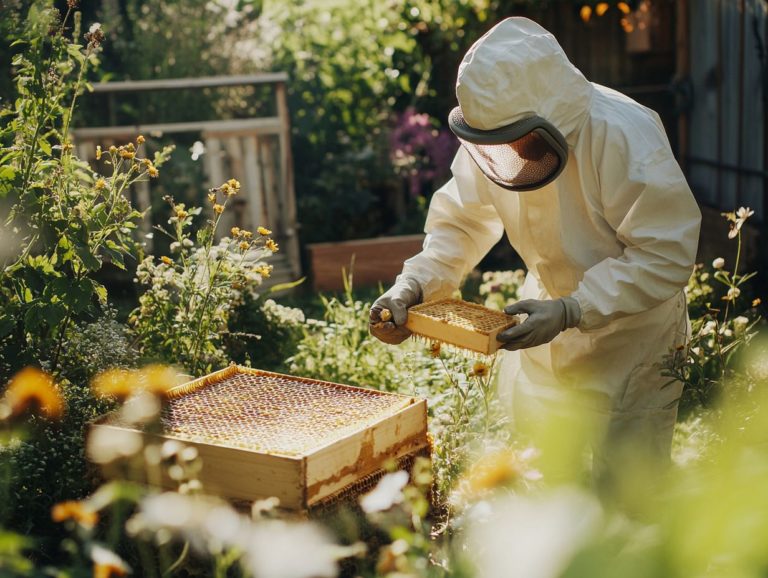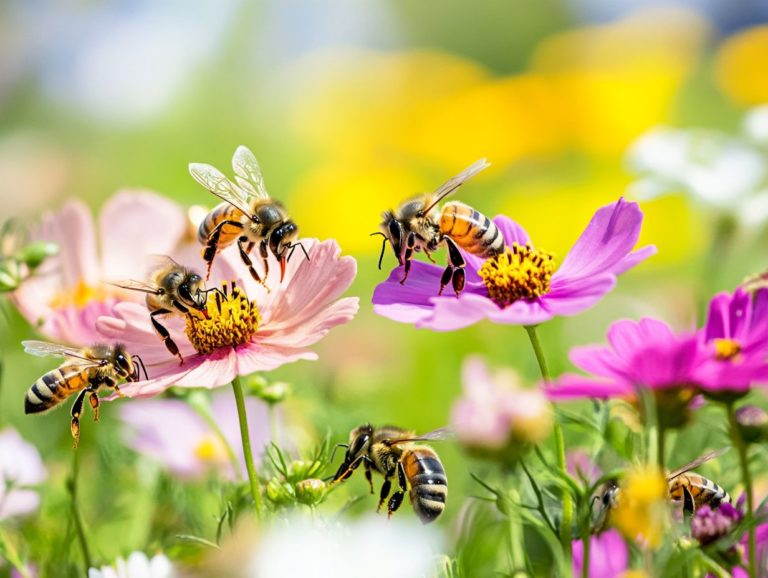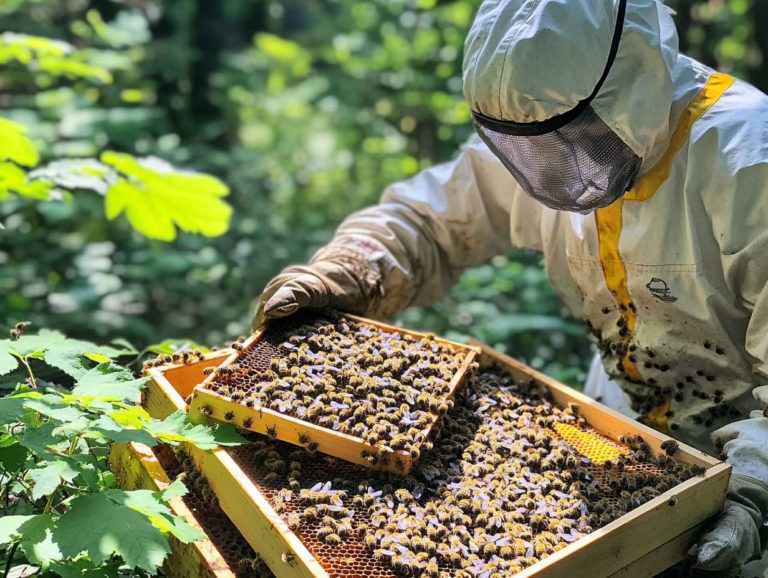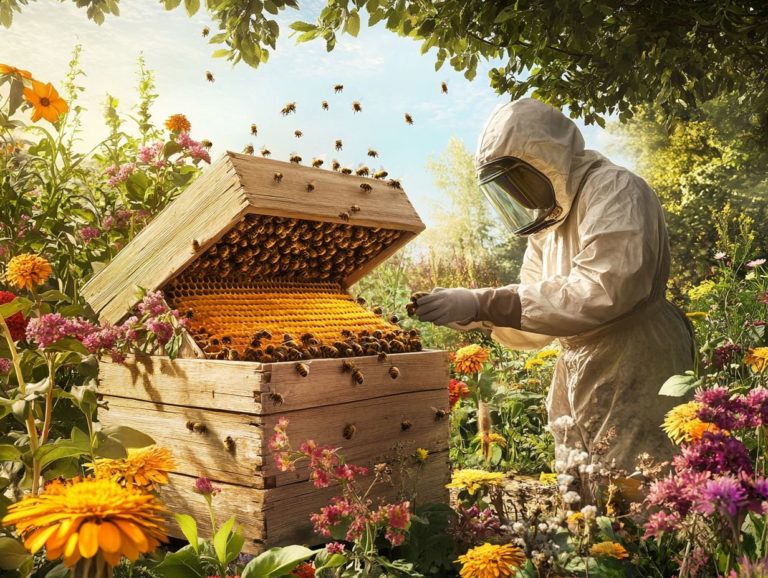How to Manage Hive Space Wisely
Effective hive space management is key to thriving in beekeeping! It is essential for maintaining the health and productivity of your bee colonies, especially during the swarming process. Key beekeeping methods include the use of queen excluders and proper frame counts.
By mastering the art of space optimization, you can dramatically boost your honey production and create thriving colonies. This exploration delves into the key factors that influence hive space, ranging from colony strength to nectar availability, while providing practical tips for measuring and determining the optimal amount of space for your bees. Embracing advanced beekeeping techniques and methods can further elevate your success in apiculture.
You ll uncover best practices to adhere to and common pitfalls to steer clear of, ensuring your hive thrives throughout the season. Effective hive management includes monitoring bee behavior and making timely interventions to support their health.
Contents
- Key Takeaways:
- Why is Hive Space Management Important?
- What Factors Affect Hive Space Management?
- How to Measure Hive Space?
- How to Determine the Right Hive Space for Your Bees?
- What are the Best Practices for Hive Space Management?
- What are the Common Mistakes in Hive Space Management?
- Frequently Asked Questions
- What is hive space and why is it important to manage it wisely?
- How can I determine if my hive has enough space?
- What are some ways to manage hive space wisely?
- Is it better to have too much or too little hive space?
- What should I do if I notice my hive is running out of space?
- Are there any other benefits to managing hive space wisely?
Key Takeaways:
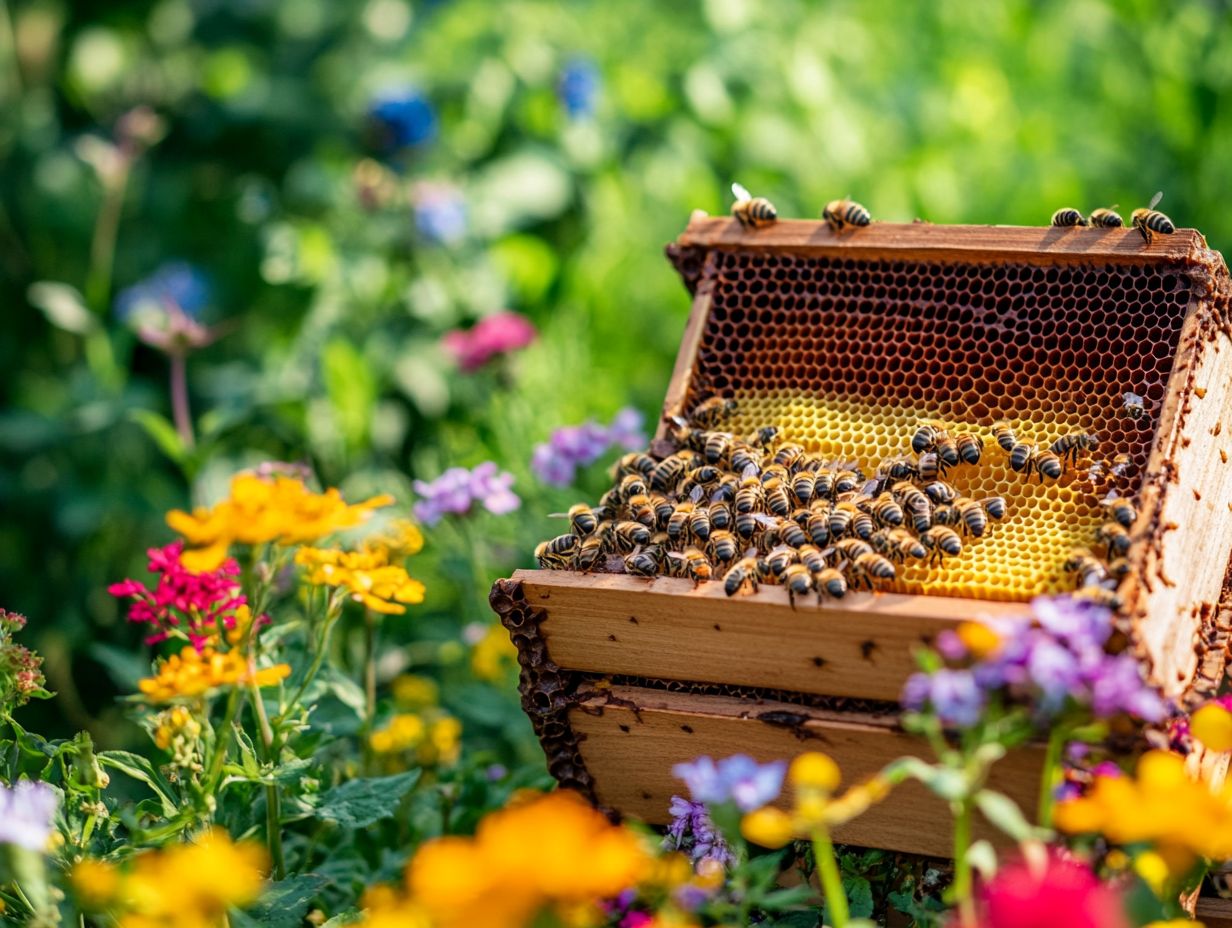
- Proper hive space management is crucial for the health and productivity of your bee colony.
- Consider factors such as colony strength, honey production, brood rearing, and the availability of pollen substitutes when managing hive space.
- Best practices for hive space management include regular inspections, rotating hive boxes, and providing adequate ventilation.
Why is Hive Space Management Important?
Managing hive space is essential in beekeeping, as it significantly influences the health and productivity of your bee colonies. When you practice proper hive management, you create sufficient room for raising young bees, enabling worker bees to effectively assist the queen in laying eggs and fostering robust colony development. This process also involves understanding bee biology and behavior to optimize the use of space.
By optimizing hive space, you enhance honey production by ensuring that there are enough honey supers extra boxes added to hives to store honey to accommodate nectar flow. This attention leads to improved hive assessments and healthier bees throughout the seasons in central Massachusetts.
Effective hive space management helps you avoid overcrowding and reduces the risks associated with swarming during peak seasons, particularly in April and August. Recognizing key dates like April 15th and August 3rd can help in planning interventions.
What are the Benefits of Proper Hive Space Management?
Proper hive space management offers a wealth of benefits, including improved honey production, enhanced brood development, and the establishment of a robust colony that can weather environmental challenges.
By providing your bees with ample space to expand their living quarters, you create an environment where colonies can truly flourish. This approach not only facilitates more accurate hive assessments but also makes it easier to monitor health indicators and implement timely interventions.
Strategic allocation of hive space can have a profound impact on brood development, resulting in healthier bees that ultimately contribute to higher yields. By employing effective beekeeping techniques, including the use of frame deeps and proper frame boxes, you can optimize honey extraction and bolster your colony’s resilience against pests and diseases, all while supporting sustainable practices that benefit both the bees and the ecosystem.
What Factors Affect Hive Space Management?
Thomas Seeley’s “Honeybee Democracy” provides insights into optimal hive space management techniques.
In terms of hive space management, several key factors come into play. You’ll need to consider the strength of your bee colonies, the levels of honey production, and your brood rearing practices. These factors are crucial whether you are managing a small apiary or large-scale commercial operations.
Additionally, the availability of pollen and nectar in the surrounding environment will significantly influence your approach. Understanding these elements will enable you to manage your hive space effectively and optimize your bees’ productivity.
Implement these practices immediately to see results in your beekeeping!
1. Colony Strength
Ensuring colony strength is vital, along with regular hive assessments to monitor health indicators.
Colony strength is a crucial element in managing hive space, as it directly influences the capacity for brood production and the queen’s egg-laying vitality.
Factors such as feeding sugar or fondant during lean periods can also support overwintering bees and maintain a strong colony.
A robust colony not only ensures thorough hive assessments but also significantly boosts honey production. When you focus on effective queen rearing techniques, you re fostering a strong genetic lineage that enhances overall colony vigor.
Maintaining optimal brood boxes provides the necessary space for developing larvae, reducing overcrowding and ensuring that your worker bees have ample room to raise more offspring.
Incorporating strategies such as regular inspections, efficient pest management, and adequate feeding during lean times can greatly sustain colony health.
Prioritize these practices to ensure a thriving hive that maximizes your honey yields!
2. Honey Production
Research published in the Journal of Economic Entomology shows the significance of hive space on honey yield.
Honey production is fundamentally influenced by the amount of available hive space. You need to ensure that your bees have ample room in honey supers to store the nectar they gather during peak nectar flow.
Utilizing honey supering techniques can maximize your yield. When you effectively manage hive space, you’re enhancing your colonies’ ability to store honey during those critical periods.
Timing is everything. For example, around April, you’ll notice the colony’s population starting to grow as the bees gear up for foraging season. If you optimize hive space at this juncture, your colony can truly thrive and collect more nectar.
In August, ensure there’s enough space for the bees to store their winter reserves.
By understanding these seasonal nuances, you can maintain robust colonies that maximize honey production while ensuring sustainability through the colder months.
3. Brood Rearing
Effective queen lay practices within brood boxes enhance overall brood production.
Brood rearing is vital for sustaining a thriving bee colony. The queen s ability to lay eggs in brood boxes directly affects overall brood production and the workforce of worker bees.
Implementing split hives can aid in managing excess space and maintaining colony health. When the queen has sufficient space to deposit her eggs, it creates an optimal environment for larvae growth, resulting in a highly efficient and energetic workforce.
Employing strategies such as regular hive inspections and maintaining appropriate spacing within brood boxes can significantly enhance the queen s egg-laying habits.
Many beekeepers adopt a technique known as managing the placement of brood frames, which involves thoughtfully relocating brood frames to boost the queen’s productivity while ensuring that ventilation and resource access remain adequate.
By maintaining a careful balance of space within the hive, you can optimize both brood development and worker bee efficiency, ultimately elevating the productivity of the entire colony.
4. Pollen and Nectar Availability
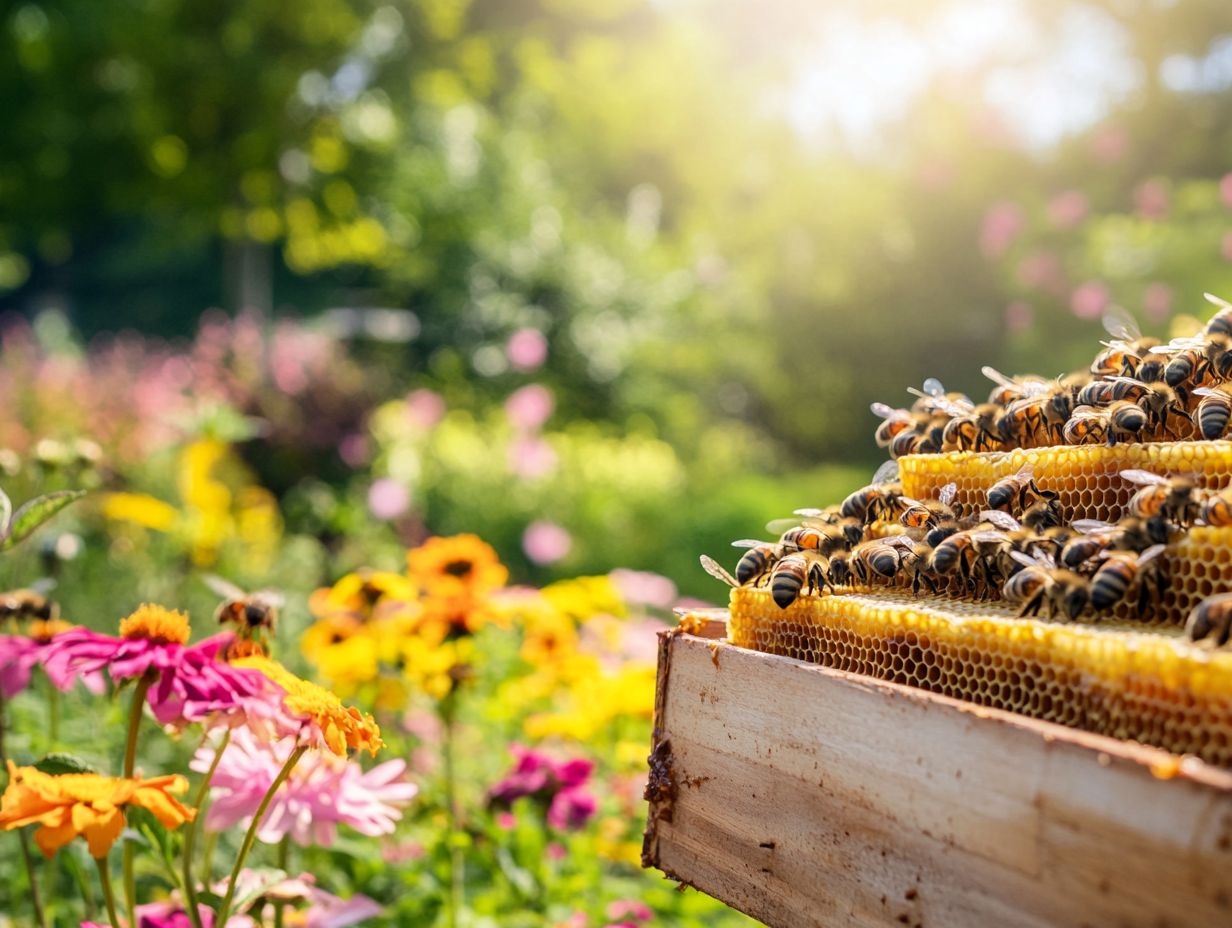
Pollen and nectar availability are essential for bee colonies, significantly impacting their capacity to produce honey and support brood rearing throughout the changing seasons.
Beekeepers often rely on dandelions in early spring and use pollen substitutes when natural sources are scarce.
The presence of dandelions and other flowering plants is pivotal, offering a rich source of both nectar and pollen. During early spring, when food sources are limited, dandelions provide the vital sustenance bees need, fostering healthier colonies and enhancing honey yields.
By diligently monitoring these environmental factors, you can effectively manage hive space and optimize feeding strategies.
Recognizing the flow of nectar and the availability of quality pollen substitutes equips you to make timely interventions, ultimately nurturing the health of your hives and boosting honey production success.
Start implementing these strategies today and watch your colonies thrive!
How to Measure Hive Space?
Accurate measurements are key to balancing excess space and maintaining optimal conditions for your bees.
Measuring hive space is crucial for effective hive management. It offers valuable insights into the current capacity for brood and honey storage. This allows you to ensure that frame counts and ventilation needs are adequately addressed. Good hive management includes using frame foundations for stability.
What are the Different Hive Space Measurements?
Hive space measurements can vary, but standard frame deeps and broad boxes play a significant role in successful honeybee management.
Different hive space measurements include the dimensions of frame boxes, brood boxes, and honey supers. These measurements are critical for determining the overall capacity of your hive. Regular beekeeping observations can help you make necessary adjustments.
Understanding these measurements is essential for effective hive management. They significantly influence the welfare and productivity of your bee colonies. For example, brood boxes typically measure 16 inches by 20 inches. This space offers ample room for the queen to lay eggs and for workers to rear brood.
On the other hand, honey supers where the bees store the honey they produce are generally smaller but equally vital for maximizing honey production.
An ideal setup could involve two brood boxes with several honey supers stacked above them. This ensures your bees have enough room to work and flourish. By meticulously assessing these dimensions, you can boost honey yield while fostering healthy colony growth.
How to Determine the Right Hive Space for Your Bees?
Selecting the ideal hive space for your bees requires thoughtful evaluation of several key factors. You must consider the type of hive, the strength of your colony, and the current conditions of the brood nest.
Each element plays a vital role in ensuring your bees thrive in their environment.
1. Consider the Hive Type
When determining the ideal hive space, it s crucial to consider the type of hive you re using, whether it has single brood chambers or frame deeps. Each design plays a pivotal role in how you allocate space and manage your bees. Proper hive ventilation and temperature control are also essential elements.
For example, hives with single brood chambers typically promote more uniform brood production. This makes them particularly suited for beekeepers who aim to maximize honey yield. On the other hand, double-deep hives offer extra room for the queen to lay her eggs. This can bolster colony strength and enhance honey production during busy peak seasons.
Incorporating a queen excluder, a tool that prevents the queen from laying eggs in the honey supers, can help preserve the purity of your harvested honey. However, using this tool improperly may restrict the bees natural behaviors, impacting the overall health and productivity of your colony.
Your choice of hive type and management practices significantly impacts both brood production and the efficiency of your honey supers.
2. Evaluate the Strength of the Colony
Beekeepers in central Massachusetts need to adapt their practices based on the unique climate conditions.
Assessing the strength of your colony is essential for determining the appropriate hive space. A robust colony needs enough frames to support both brood rearing and honey production. Managing splits effectively can also help maintain colony strength.
To evaluate your colony’s strength, regular hive inspections are crucial. During these evaluations, observe the behavior and health of the worker bees and the extent of brood coverage. A thriving colony typically showcases vigorous worker activity, and a well-distributed brood pattern often indicates a healthy queen. This information illuminates the current vitality of your colony and informs decisions about hive space management. Referencing works like Thomas Seeley’s Honeybee Democracy could provide valuable insights.
Determining the optimal frame counts ensures that each hive has the necessary resources for expansion and production, especially during peak seasons.
3. Observe the Brood Nest
April and August mark significant periods for brood nest inspections to optimize colony health.
Get ready to boost your hive s productivity! Observing the brood nest is essential for grasping the needs of the colony; it reveals the queen’s laying patterns and the overall condition of the frames within the brood boxes.
By closely monitoring brood nest conditions, you can identify key indicators that signal whether your hive requires more space or adjustments to boost productivity.
Signs such as excessive drone brood, a reduced presence of worker bees, or a tightly packed brood nest serve as clear clues that additional frames may be necessary to accommodate the growing population. Climate-controlled environments can aid in more precisely managing these conditions.
Transitioning from a crowded brood box to a new one can alleviate stress on the colony, promoting a vibrant and healthy brood cycle.
Regular inspections give you the power to manage proactively, ensuring optimal conditions that support a thriving bee habitat and maximize honey production.
What are the Best Practices for Hive Space Management?
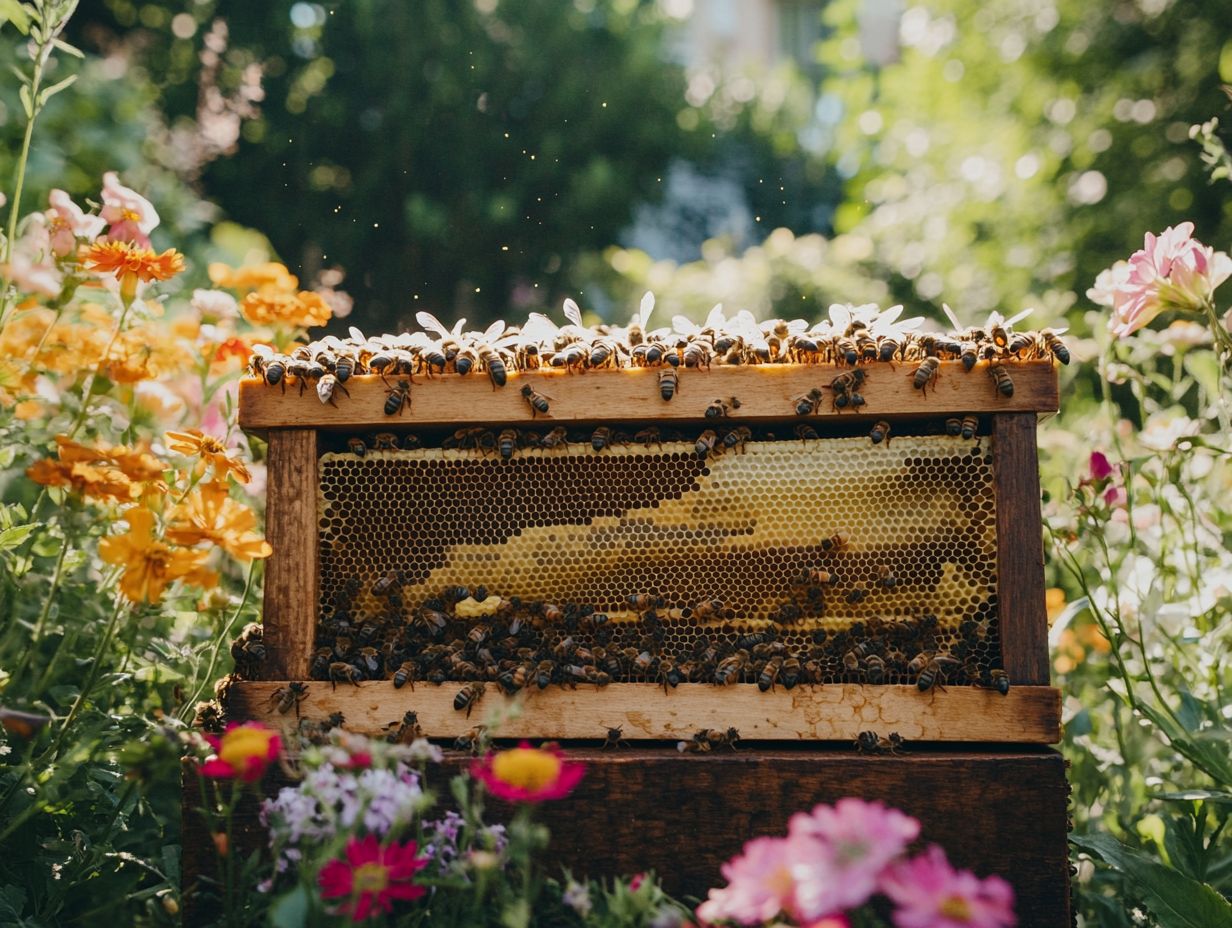
According to the Journal of Economic Entomology, effective hive space management is crucial for optimal productivity.
In terms of managing hive space effectively, adopting best practices is key. This involves checking your hives regularly, ensuring that ventilation needs are adequately met, and making informed choices about the use of frame boxes and brood boxes.
By prioritizing these elements, you enhance the overall health and productivity of your hives. Incorporating the feeding of fondant during nectar scarcity can be particularly beneficial.
1. Regular Inspections
Don’t wait for problems to arise; inspect your hives regularly to prevent issues before they start! Conducting regular inspections is an essential part of effective hive management, allowing you to gauge the conditions of your hives and the strength of your colonies.
These inspections serve as a crucial opportunity not just to spot any troubling issues but also to embrace a proactive approach in maintaining the overall health of your hives. Observing egg laying patterns can give you a clearer picture of the queen’s productivity.
By routinely checking for signs of diseases like Varroa mites (a type of pest that can harm bees), American foulbrood, or even poor nutrition, you can make informed decisions that ensure optimal productivity.
Observing robust brood patterns, ample honey stores, and active foraging behavior are key indicators of your colonies vitality. The use of cattle ear tags can sometimes help in identifying and managing individual hives effectively.
Keeping an eye out for pests and any unusual behavior among your bees provides valuable insights into their well-being, giving you the power to create a thriving environment for them.
2. Rotate Hive Boxes
Transform your hive into a buzzing success! Rotating hive boxes serves as an effective strategy for you to maintain healthy bee colonies while optimizing space for both brood and honey production.
By periodically shifting hive boxes, you can significantly enhance ventilation within the hive. This improved airflow aids in regulating temperature and humidity, creating a more favorable environment for your bees to thrive.
Rotating frames promotes better utilization, encouraging your colonies to explore and populate all available space, which ultimately leads to increased honey yields.
Timing your rotations is crucial; act quickly during nectar flow periods to reap the maximum benefits. Moreover, observing hive dynamics and ensuring that your rotation does not disrupt the colony’s established patterns are essential for successful implementation.
3. Provide Adequate Ventilation
Providing adequate ventilation in your hive is essential for maintaining optimal temperature control. This directly supports the health and productivity of both the queen and the worker bees.
If your hive becomes too warm, it risks overheating. This stresses the colony and may lead to fewer bees or less honey. Stagnant air creates moisture buildup, setting the stage for issues like mold and disease that can jeopardize the hive’s well-being.
To enhance ventilation, consider the strategic placement of your hives to maximize airflow. Think about installing screened bottom boards that facilitate free air movement while keeping pests at bay. Monitor and adjust your ventilation systems regularly, possibly incorporating insulated covers with ventilation holes to retain warmth while allowing moisture-laden air to escape.
By following these tips, you can supercharge your colony’s vitality like never before!
4. Use Queen Excluders
Queen excluders are particularly useful for managing colonies during the height of the September honey collection period.
Using queen excluders is an essential technique in hive management that gives you the power to control the movement of the queen between brood boxes and honey supers.
This tool acts as a barrier, effectively preventing the queen from laying eggs in the honey supers. This ensures that the honey you collect remains free from brood. By keeping the honey areas devoid of developing larvae, you can significantly enhance both the efficiency of your honey harvesting and the overall health of your hive. This allows your worker bees to focus on foraging and honey production.
For optimal results, implement queen excluders during the peak honey flow, typically in the spring when the queen is actively laying eggs. Regularly monitor hive conditions and consider combining this practice with routine inspections and feeding, especially during periods of nectar scarcity, to maintain a well-managed and productive hive.
Start using queen excluders today to maximize your honey harvest!
What are the Common Mistakes in Hive Space Management?
Common mistakes in managing your hive space can significantly impact the health of your colony, decrease honey production, and complicate brood rearing. These issues can ultimately affect your overall hive assessments, making it crucial to approach hive space management with care and precision.
1. Not Providing Enough Space
One of the most critical mistakes you can make in hive space management is failing to provide enough room for your colony. This can quickly lead to overcrowding and stress among the bees.
This overcrowding can have serious consequences for the overall health of your colony, impacting brood production, honey yield, and the bees ability to thrive. When a hive becomes cramped, your bees may struggle to care for their young, resulting in decreased brood numbers and weakened immune systems. A stressed colony simply cannot forage effectively, which translates to lower honey production.
To avoid these problems, make it a habit to inspect your hives regularly and add additional supers before overcrowding becomes an issue. Employ strategies like routine population assessments and ensuring proper ventilation within the hive to help maintain optimal conditions, ultimately fostering a robust and productive colony.
2. Not Checking for Queen Cells

Neglecting to regularly check for queen cells may lead to unexpected swarming events, which can significantly impact your hive assessments and the overall strength of your colony.
By keeping a vigilant eye on these critical indicators, you can effectively manage your colonies, ensuring they remain robust and productive. Monitoring for queen cells not only helps prevent swarming but also plays a crucial role in optimizing brood rearing.
When you identify queen cells early, you can take prompt action to either bolster the existing colony or facilitate the creation of new ones.
This proactive approach enhances your hive management outcomes, resulting in healthier bees and increased honey production, ultimately benefiting both you and your buzzing companions.
3. Using Improper Hive Boxes
Using the right hive boxes can make your beekeeping journey much smoother and more enjoyable! Improper hive boxes can be a significant challenge during sensitive periods like April 15th and August 3rd.
When you use improper hive boxes, it can impede your hive management efforts by limiting the space for brood production and honey storage. This limitation ultimately impacts the overall health of your colony.
Choosing the correct hive boxes is paramount for thriving in beekeeping. Different types of boxes exist, such as brood boxes for nurturing young bees and honey supers for storing surplus honey. Each type should be selected based on your colony’s specific needs. Thomas Seeley’s work in Honeybee Democracy provides excellent guidelines on this topic.
For instance, opting for deeper brood boxes creates ample space for the queen to lay eggs, promoting a robust population. Meanwhile, lighter honey supers facilitate easier honey harvesting, ensuring you don t overwhelm your bees. Proper ventilation and pest management are crucial, especially in climates like central Massachusetts, to maintain the strength and longevity of your hive.
Frequently Asked Questions
For more insights on hive management, refer to Thomas Seeley’s book Honeybee Democracy.
What is hive space and why is it important to manage it wisely?
Hive space is the area where honeybees build and store their honeycombs. Managing this space wisely ensures a healthy and productive hive while avoiding issues such as overcrowding or lack of storage. This is particularly crucial during peak seasons like April and August.
How can I determine if my hive has enough space?
To know if your hive has enough space, check it regularly. Monitor honey stores and observe your bees’ behavior for clues. If they seem cramped or agitated, they may need more space. You can also refer to resources like the Journal of Economic Entomology for the latest research on hive management.
What are some ways to manage hive space wisely?
One effective way is to regularly check your hive and adjust the number of frames to maintain appropriate space. Another method involves using queen excluders devices that prevent the queen from laying eggs in honey supers to save valuable space. Ensure your hive is well-ventilated and climate-controlled for the best living conditions for your bees.
Is it better to have too much or too little hive space?
Too much hive space can force bees to work harder to regulate temperature, which can be energy-consuming. Conversely, too little space causes overcrowding and congestion, leading to potential issues within the hive. During times of limited space and resources, feeding fondant can support your bees.
What should I do if I notice my hive is running out of space?
If your hive is running out of space, add more frames or honey supers to provide additional room. Regularly monitor the space and make adjustments as needed to prevent potential issues, especially during harvest periods like September honey collection.
Are there any other benefits to managing hive space wisely?
Beyond ensuring a healthy and productive hive, managing hive space wisely makes honey harvesting easier and more efficient. It also helps prevent swarming, as overcrowding is a primary reason bees swarm. Effective pest management, particularly against the Varroa mite, is essential for healthy hive management.

